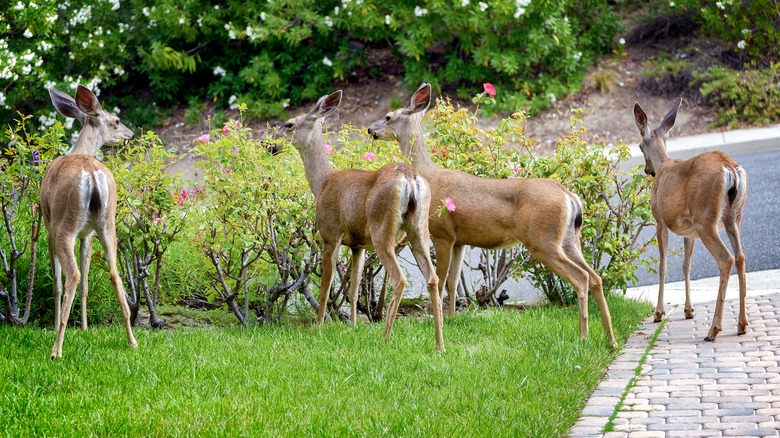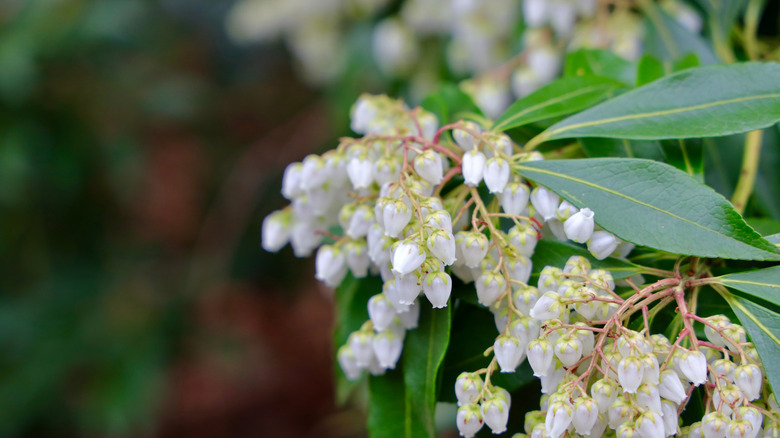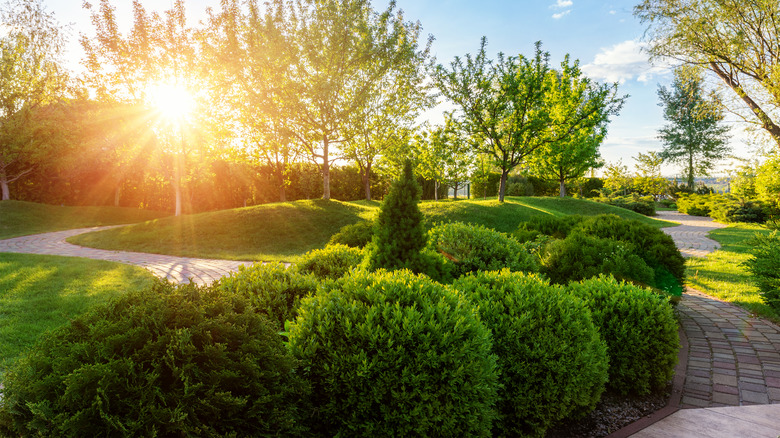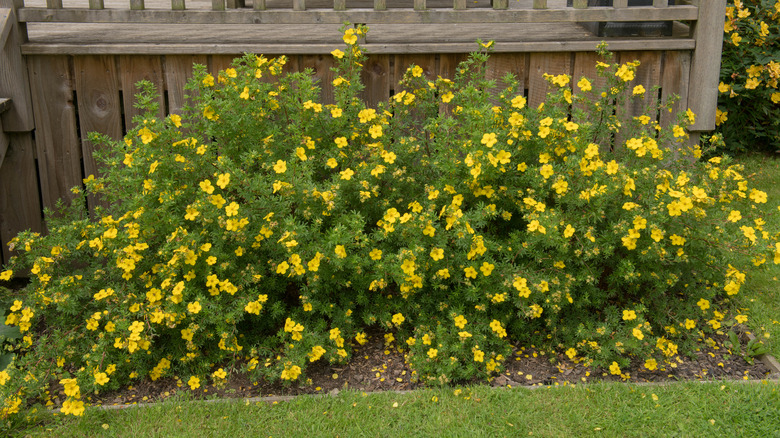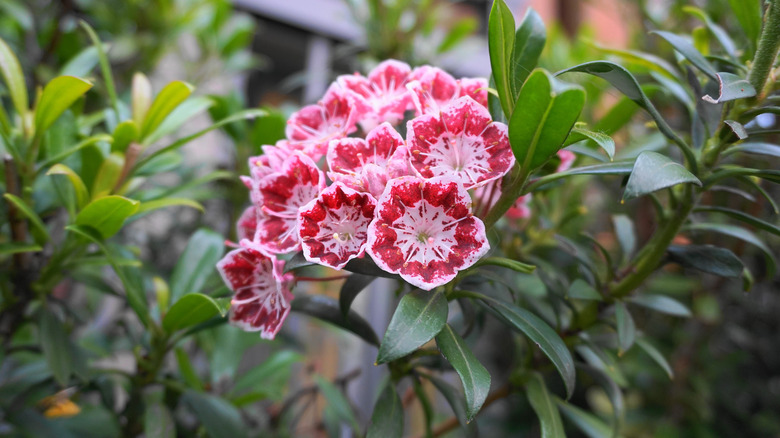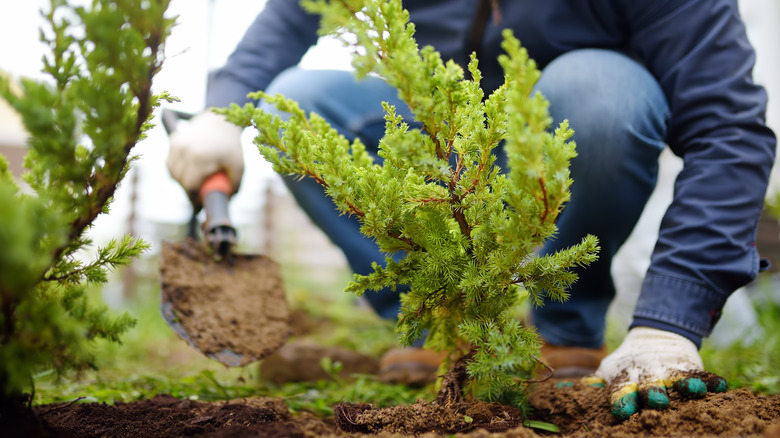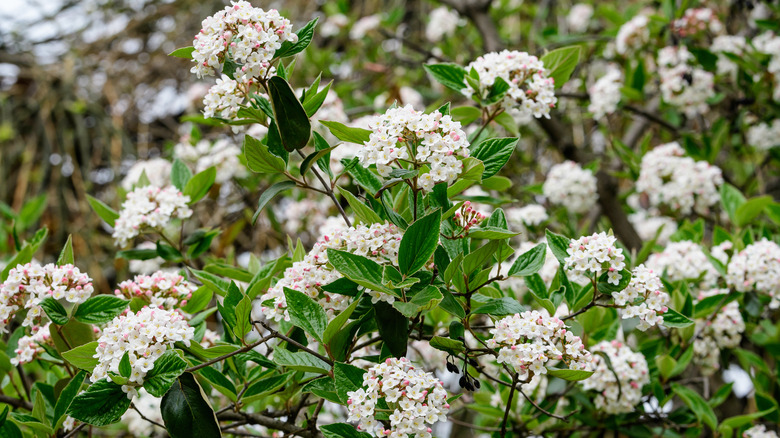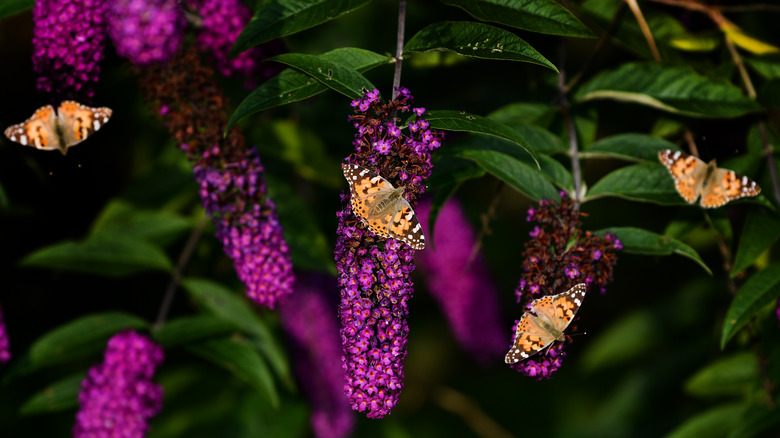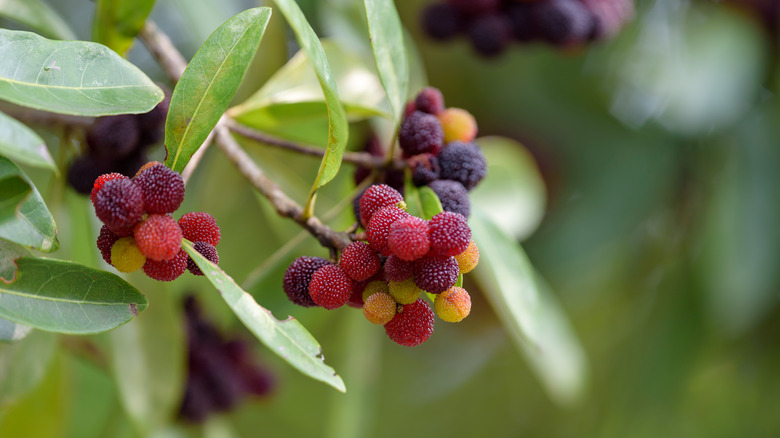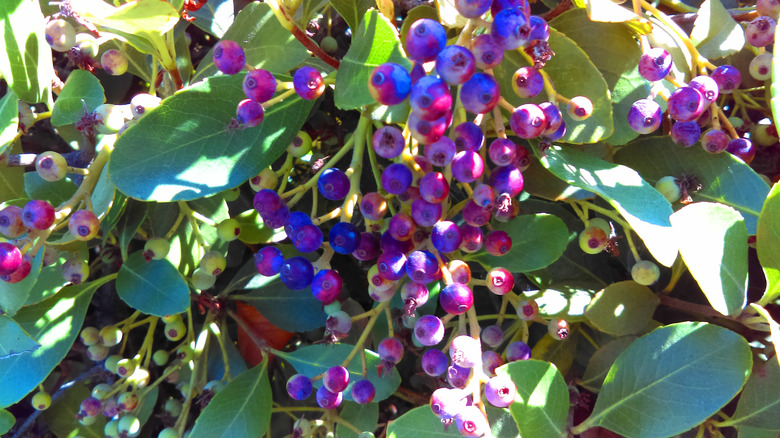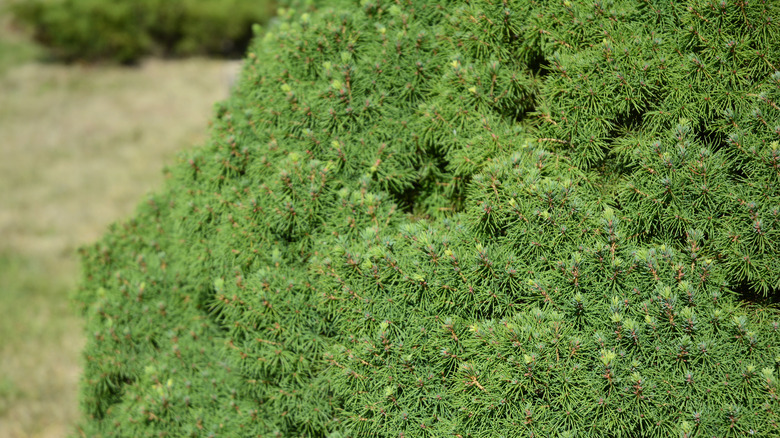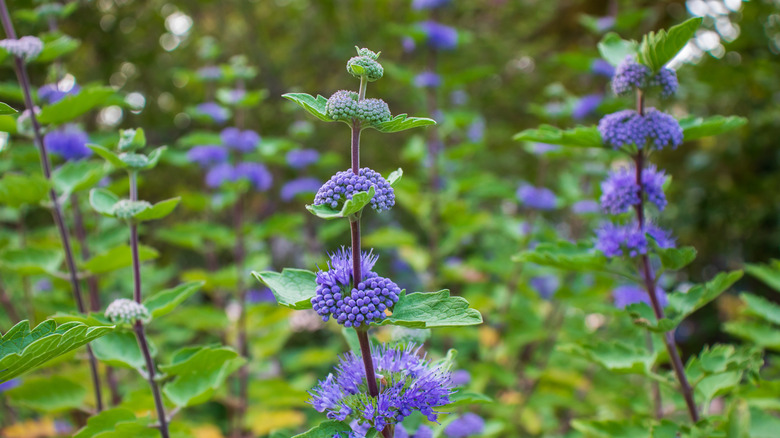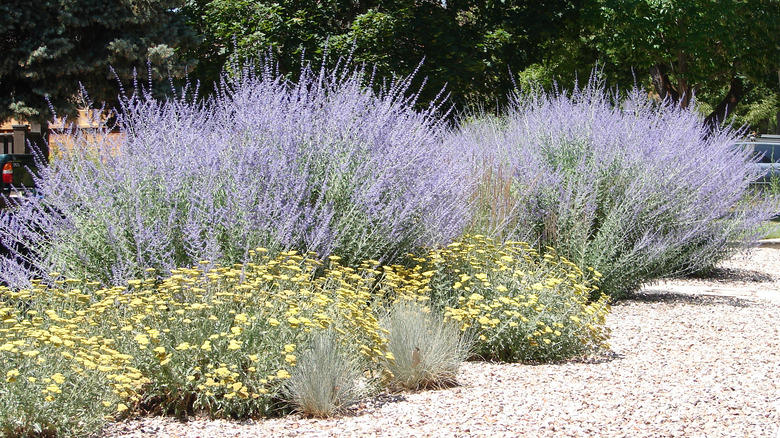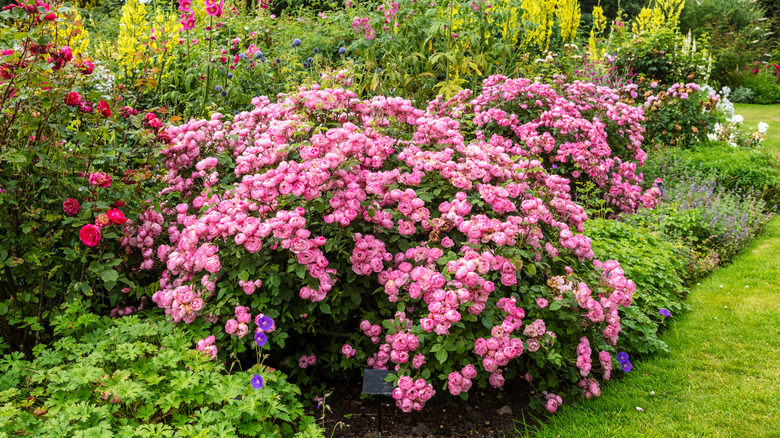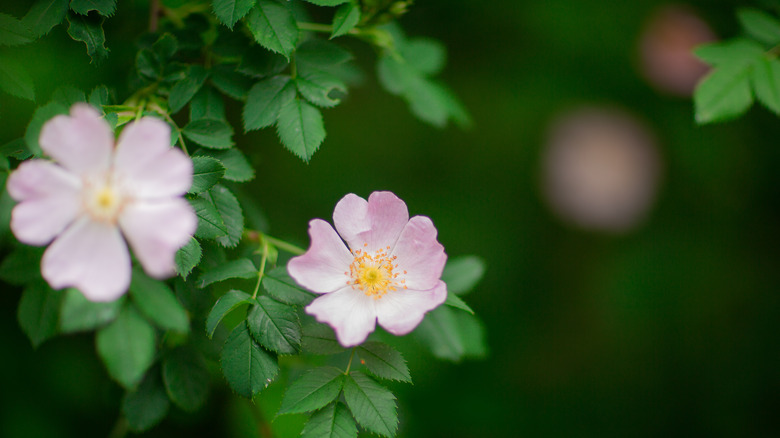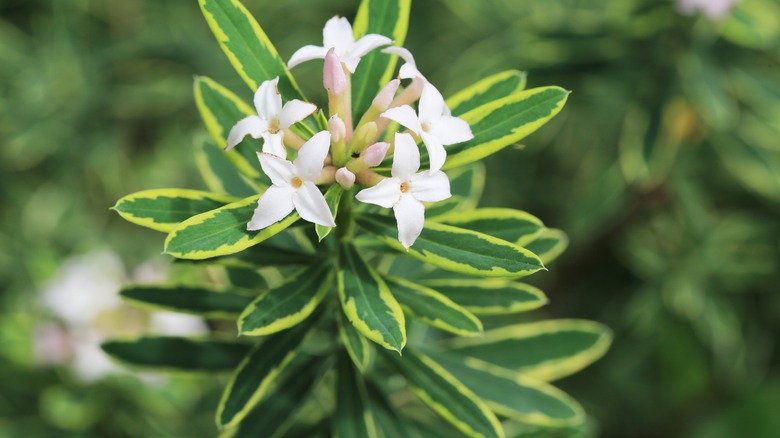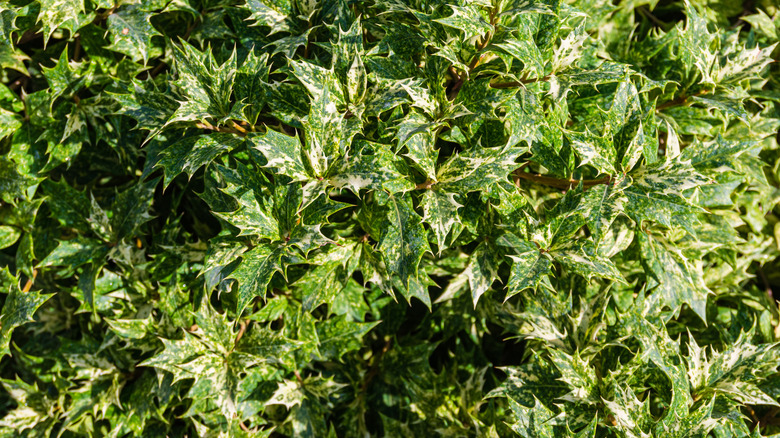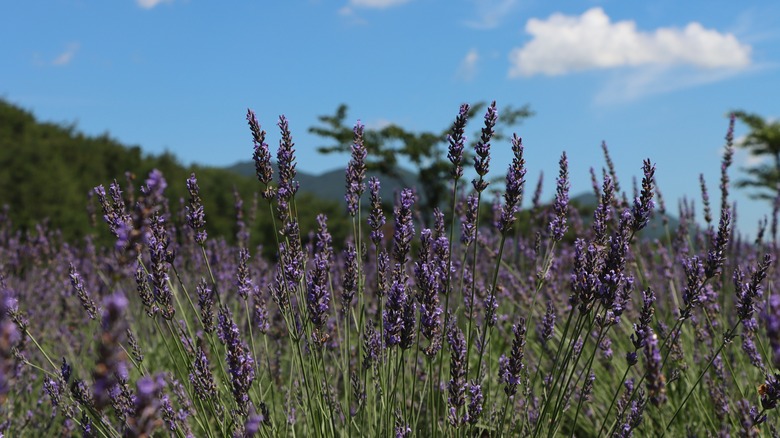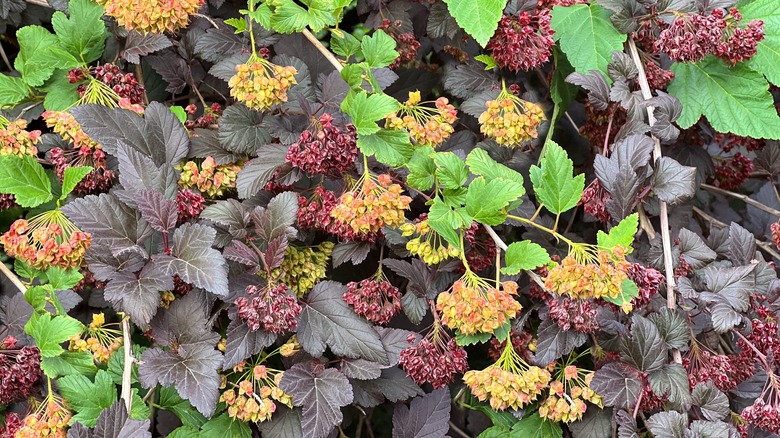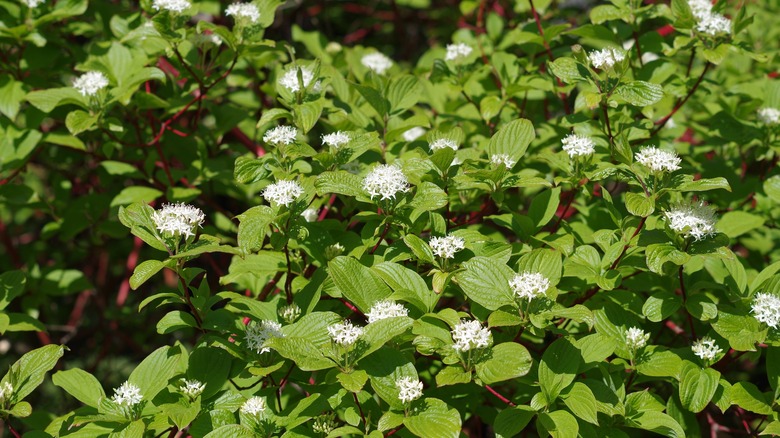19 Deer-Resistant Shrubs To Landscape Your Yard & Protect Your Garden
Your local deer population won't hesitate to feast on the greenery in your country yard unless you've planted deer-resistant shrubs. It's all in the nose, the Scottish Wildlife Trust points out. A typical deer has 250 million scent receptors — compared to our 5 million — making their sense of smell 1,000 times better than ours. This explains why they turn up their noses at the fragrant plants we love, considering them smelly due to the intensity with which they perceive them.
As a homeowner living in a rural area, you can plant deer-resistant shrubs as hedges to discourage unwanted wildlife from destroying your property. These shrubs offer other great benefits, too; they can improve your privacy, provide shade, add color and structure to your home, and create a habitat for pollinators. To create a thriving landscape you can enjoy, consider our top picks of deer-resistant shrubs that are perfect for your country yard.
1. Japanese andromeda
Perhaps what your country yard needs is Japanese andromeda (Pieris japonica), an evergreen shrub that's native to eastern Japan, Taiwan, and China. Though slow-growing, it eventually becomes a small tree, via North Carolina State University, and keeps deer away all year-round successfully. It also impresses with a stunning cluster of white or pink flowers set against dark, green leaves.
Bloom Season: late winter, early spring
USDA Growing Zone: 5 to 9
Growing Conditions: full sun to partial shade
Soil Type: moist, well-draining, acidic
Size: 9 to 13 feet tall, 6 to 8 feet wide
2. Boxwood
Boxwood (Buxus) is one of the most effective deer-resistant shrubs you can plant in your country yard, per The New York Times. Plant them in groups to create a hedge or matching border. Boxwoods love the sun and regular watering until established. You'll enjoy them because they're low-maintenance, only requiring annual pruning to keep them in elegant shape, according to Gardening Know How.
Bloom Season: spring
USDA Growing Zone: 5 to 8
Growing Conditions: full sun to light shade
Soil Type: organic, neutral soils with a pH of 6.5 to 7.5
Size: 1 to 20 feet tall, 2 to 8 feet wide
3. Shrubby cinquefoil
Shrubby cinquefoil (Potentilla fruticosa), or potentilla shrubs as they're known in some circles, offer structure, color, and versatility to any landscape. Plant them for firescaping, erosion control, or hedging around your gorgeous country yard, per Garden Beast. Deer aren't particularly fond of these shrubs because they find their foliage unappealing. Shrubby cinquefoil doesn't do well in the summer heat, and prefers cooler climates.
Bloom Season: spring to fall
USDA Growing Zone: 2 to 8
Growing Conditions: full sun, little fertilizer
Soil Type: low to medium fertile soil, well-draining
Size: 3 feet high, 3 to 4 feet wide
4. Mountain laurel
Our list of deer-resistant shrubs will be incomplete without mentioning the ever-popular mountain laurel (Kalmia latifolia). The eastern North American native is a flowering, evergreen shrub that grows in habitats such as cool meadows, mountain slopes, and rocky woods. It's beautiful and wild, producing oval leaves and large clusters of rosy, pink, white, or red flowers, via Better Homes & Gardens.
Bloom Season: late spring to early summer
USDA Growing Zone: 5 to 9
Growing Conditions: prefers part shade, tolerates full sun
Soil Type: cool, rich, moist, well-draining, acidic
Size: 8 to 20 feet high, up to 12 feet wide
5. Juniper
As members of the cypress family, more than 100 varieties of juniper (Juniperus spp.) grow across the U.S. Juniper is dioecious and sweet-scented, giving off a heavy fragrance of incense, cedar, lemons, or apples when their leaves are crushed, Rootwell says. But because deer have sensitive noses, they dislike it, according to Garden Guides. Homeowners, on the other hand, love juniper for being low-maintenance, hardy, and drought-tolerant.
Bloom Season: late winter to early spring
USDA Growing Zone: 2 to 8
Growing Conditions: full sun, infrequent waterings
Soil Type: sandy, well-draining
Size: 6 inches to 130 feet tall, 1 to 25 feet wide
6. Arrowwood viburnum
Arrowwood viburnum (Viburnum dentatum) is one of the best deer-resistant shrubs you can plant in your country yard. With this shrub, you get a three-for-one deal: edible blue-black berries, showy white flowers, and stunning yellow, orange, or red foliage in the fall. Plant arrowwood viburnum in the spring or late fall as hedges, and water only when the soil begins to dry out, per The Spruce.
Bloom Season: spring
USDA Growing Zone: 2 to 8
Growing Conditions: full sun to partial shade
Soil Type: loamy, moist, acidic, well-draining
Size: 6 to 10 feet tall, similar spread
7. Butterfly bush
Beautify your country yard and keep deer away with butterfly bush (Buddleja davidii). Also known as summer lilac, this Japan and central China native offers long-spiked trusses that butterflies find appealing. It's fast-growing, producing a variety of flowers in pretty colors: mauve, lavender-pink, and deep purple. Butterfly bushes are easy to grow and low-maintenance, only requiring deadheading to maintain their dense shape and encourage flowering.
Bloom Season: summer to fall
USDA Growing Zone: 5 to 9
Growing Conditions: full sun
Soil Type: fertile, well-draining
Size: 6 to 10 feet tall, 4 to 10 feet wide
8. Bayberry
What you need in your country yard is bayberry (Myrica pensylvanica), a deciduous shrub native to North America. It typically grows along the eastern coast of the U.S. Bayberry is ecologically valuable and marked as one of the most effective deer-resistant shrubs for homeowners. Per The Morton Arboretum, you can identify this plant by its upright-rounded appearance, aromatic flowers, and lustrous, dark-green leaves.
Bloom Season: spring
USDA Growing Zone: 3 to 9
Growing Conditions: full sun to partial shade
Soil Type: partial to moist, well-draining
Size: 5 to 10 feet tall, similar spread
9. Inkberry holly
Though Inkberry (Ilex glabra) is resistant to deer damage and attracts songbirds. If you don't mind, go ahead and plant this evergreen shrub from the holly family. It's easy to grow, naturally appearing as a broadly rounded mound with glossy dark-green leaves. Inkberry works well when grouped as borders, but can form colonies quickly. To keep it in check, trim the plant each spring, advises North Carolina State University.
Bloom Season: spring
USDA Growing Zone: 4 to 10
Growing Conditions: full sun to partial shade
Soil Type: rich, moist, and acidic
Size: 5 to 8 feet high, similar spread
10. Dwarf Alberta spruce
If you're researching deer-resistant shrubs for your country yard, opt for Dwarf Alberta spruce (Picea glauca). It's a dense, non-flowering shrub that resembles a miniature Christmas tree, as stated by HGTV. Dwarf Alberta Spruce is evergreen, has a fuzzy appearance, and features 3/4 inch long aromatic green needles. Typically, its annual growth doesn't exceed 2 to 3 inches.
Bloom Season: spring
USDA Growing Zone: 2 to 7
Growing Conditions: full sun to partial sun
Soil Type: light, fast-draining, pH of 5.0 to 7.0
Size: 2 to 4 feet tall, 1 to 2 feet wide
11. Bluebeard
Bluebeard (Caryopteris X Clandonensis) will ensure that hungry deer won't treat your country yard like an all-you-can-eat buffet. Per Fine Gardening, this herbaceous perennial can tolerate the worst conditions, including humidity, drought, and extreme heat. It's native to East Asia and produces scented, blue flowers from mid-summer to early fall. As hedges, bluebeard forms finely-textured mounds that are virtually pest-free but attract hummingbirds, bees, and butterflies.
Bloom Season: summer
USDA Growing Zone: 6 to 9
Growing Conditions: full sun or light shade
Soil Type: well-draining, neutral pH
Size: 1 to 3 feet high, 3 to 6 feet wide
12. Russian sage
As confirmed by Gardenia, Russian sage (Perovskia atriplicifolia) is a deciduous perennial that works well with other desert plants. It's perfect for xeriscaping since it can resist pests, drought, poor soils, and heat. Russian sage is one of the few deer-resistant shrubs that deters rabbits. To see healthy, lavender-blue flowers and scented gray-green leaves, divide the plants every four to six years to refresh them.
Bloom Season: late spring to fall
USDA Growing Zone: 5 to 9
Growing Conditions: full sun
Soil Type: well-draining, preferring alkaline soils
Size: 3 to 5 feet tall, 2 to 4 feet wide
13. Shrub roses
Deer dislike shrub roses (Rosa spp.) for their clove-like scent and thorns. If you decide to plant this American native, you'll have to choose from over 300 species and tens of thousands of hybrids, ranging from snowy white to deep purple, Gardeners Path says. Pro tip: Only plant shrub roses when temperatures are between 40 and 60 degrees to allow sturdy roots to form.
Bloom Season: various, depends on species
USDA Growing Zone: 3 to 11
Growing Conditions: full sun
Soil Type: well-draining, full of humus
Size: 1 to 20 feet tall, 1 to 15 feet wide
14. Swamp rose
A deer-resistant shrub like the swamp rose (Rosa palustris) should be on your radar. It's from North America and is often found in acidic wetlands and riversides. According to Wildflower, swamp roses grow upright, producing numerous thorny stems, dark-green leaves, and delicate rose-pink flowers. You'll love it in your country yard, even more when its aroma fills the air.
Bloom Season: spring and summer
USDA Growing Zone: 4 to 9
Growing Conditions: full sun or partial shade
Soil Type: wet, fertile
Size: up to 7 feet tall, 1 to 2 inches wide
15. Daphne
Daphne (Daphne x burkwoodii "Carol Mackie") is a variegated bush that's perfect for foundation plantings and shrub borders. It has a wide native range, from Europe to Africa, and produces gray-green leaves and fragrant clusters of pale pink flowers, via Gardenia. Deer detest its aroma and poisonous berries. Note that Daphne's berries are toxic to people and pets, too, so be careful when handling the shrub.
Bloom Season: winter, spring
USDA Growing Zone: 4 to 9
Growing Conditions: part sun to part shade
Soil Type: rich, moist, well-draining, neutral to acidic
Size: 3 to 4 feet, similar spread
16. False holly
With its subtle blooms and variegated foliage, the false holly (Osmanthus heterophyllus) is unique compared to other decorative flowers and shrubs. Both its fruits and flowers sprout in late autumn and winter, making this plant a late bloomer compared to most plants. The fruits are often described as olive-like due to their size and dark rounded shape, while the minuscule white blossoms provide a stunning contrast to the leaves. The fruits are not edible and the flowers aren't bountiful, making the plant undesirable to deer and other wildlife. Although wild animals may not be attracted to it, people tend to be fond of the false holly's eccentric shape and coloring of its leaves.
Bloom Season: year-round for foilage, autumn/winter for flowers/fruit
USDA Growing Zone: 7 to 9
Growing Conditions: partial shade to full sun
Soil Type: loamy to some clay, fertile, well-draining
Size: up to 4 feet high, 3 to 5 feet wide
17. English lavender
If you're looking for fragrant but eye-catching flowers that won't appeal to the local deer population, you should consider planting English lavender (Lavandula angustifolia) in your garden. These popular flowers have a fresh floral fragrance that people tend to enjoy, but deer are not so fond of. This species is a great companion plant in vegetable, fruit, and floral gardens, giving you a low-maintenance option for defending against wildlife invasions. These plants also repel insects, such as mosquitos and flies, making them extra functional for clearing up unwanted visitors from your yard. Plus, you can snip a few stems to place around your home for a welcoming scent.
Bloom Season: summer
USDA Growing Zone: 5 to 8 (this is the most resilient lavender variety for northern areas)
Growing Conditions: full sun, avoid shade and damp areas
Soil Type: alkaline, chalky, dry, well-draining soil encourages a stronger fragrance
Size: 2 to 3 feet high, 2 to 4 feet wide
18. Ninebark
Ninebark (Physocarpus) isn't entirely deer-resistant, though many deer will avoid this plant once it matures. These deciduous plants often survive in areas with prominent deer populations, despite their clusters of flowers and fruits that give off a light sweet scent. If local deer do graze on this plant, they do not prefer the taste and typically leave the ninebark alive and intact. Many varieties of this shrub, such as mallow and mountain ninebark, attract butterflies and honeybees, which pollinate gardens and encourage growth, making them great additions to your home garden.
Bloom Season: late spring to summer for fruits/flowers, winter for bark
USDA Growing Zone: 3 to 7, but they can also be grown in 2 and 8 with special care
Growing Conditions: full sun to partial shade
Soil Type: neutral to slightly acidic, well-draining, organic mulch recommended
Size: 3 to 10 feet high, 3 to 12 feet wide
19. Red twig dogwood
Many dogwood species are deer-resistant, but red twig, also known as "red osier", dogwood (Cornus sericea) is one of the more resilient types. These shrubs can grow up to two feet a year and reach maturity quickly. This makes them unappealing as snacks for curious wildlife since deer prefer grazing on plants like grass that is softer and, therefore, easier to consume. Red twig dogwood are deciduous flowering shrubs that thrive in swamplike conditions, making them suitable for moist and muddy areas where it's typically difficult to raise plants. Aspiring gardeners should know that placing them in sunny, brightly lit locations brings out more vibrant colors while placing them in shaded areas encourages more muted hues.
Bloom Season: spring
USDA Growing Zone: 3 to 8
Growing Conditions: full sun to partial shade
Soil Type: acidic, fertile, moist
Size: 6 to 9 feet high, 8 to 12 feet wide
